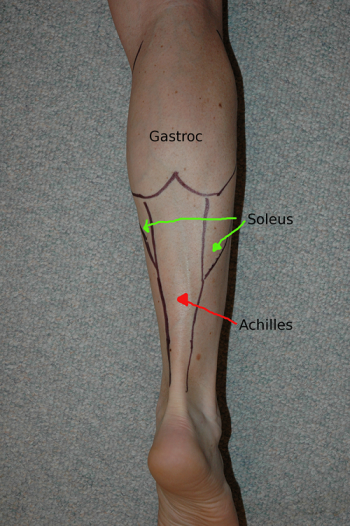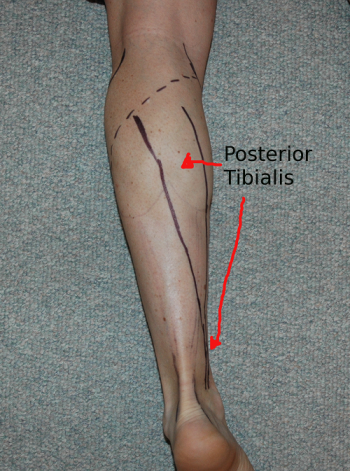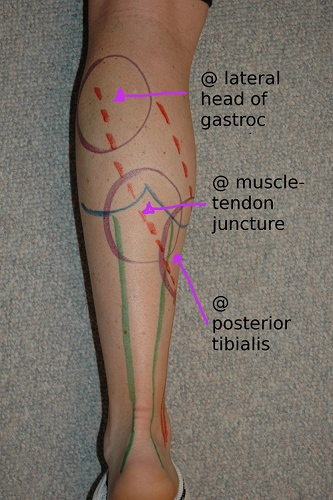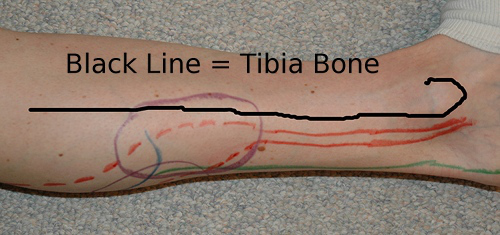Self Muscle Massage- Pt 1 The Calf
In the introduction to the Self Muscle Massage series, we discussed and demonstrated the three different techniques that will be used. Click here if you missed them or would like to review them.
In this part of the series, we’re going to start with the calf muscles. They play a major role in shock absorption as you step onto your foot, provide control and balance as you move over your foot/ankle from double to single leg stance, and assist in propulsion as you push off of your toes at the end of the gait cycle. With that in mind, they are a common source of problems in the lower extremities. Tight calf muscles can lead to problems both in the foot and shin, as well as, up the chain into the knee, hip, and back.
There are three primary muscles in the calf region. To make it easier to locate them, let’s break them up into two layers of muscles.
1) Superficial Muscles
There are two muscles in the top (superficial) layer- the gastroc and the soleus. The gastroc is the easiest and most visible of all the calf muscles- it’s the two bumps that pop out when you step up on your toes. The soleus muscle is underneath the gastroc and lower down the leg (think just below the two muscle bellies (bumps) of the gastroc on either side of the achilles tendon/ or mid-way between the knee and heel). Both of these muscles become the Achilles Tendon which inserts into the back of your heel. The main difference between the two muscles is in how they work. The larger gastroc muscle helps you push off of your toes when the knee is straight versus the soleus muscle which does the same thing while the knee is bent. For example- it is very common for runners to have sore and stiff soleus muscles following a hilly run when they are unable to fully extend the knee and push off going uphill and when the knees are bent and shock absorption is increased coming downhill.
2) Deep Muscles
In the second layer of muscles is your posterior tibialis. This muscle is located deep to both the soleus and gastroc. It runs down the middle of the back of your lower leg before moving towards the inside of the leg and down the tibia. It’s tendon can be felt as it wraps around the inside ankle bone (medial malleolus) and inserts into the arch of your foot. The reason that I want to involve this muscle is that it is frequently involved in plantar fasciitis/heel injuries and is a sight of tendonitis behind the ankle. The post tib helps support the arch and maintain heel position as you step onto your foot. From a muscle action perspective, the post tib plantar flexes the ankle (points the toes down) and inverts the calcaneous (points the toes in towards the midline of the body). As the larger calf muscles fatigue/stiffen, it is very common for the posterior tib to help compensate by helping with push off and toe clearance. The result is frequently the foot swinging through with the arch positioned up towards the sky instead of down towards the ground. The post tib can also be a source of “shin splints” because of this.
Soft Tissue Techniques
What you’ll need: a foam roller and a tennis/trigger point ball.
The techniques:
1) Elongation/lengthening with the foam roller.
2) Cross friction with the tennis ball
3) Sustained pressure/trigger point release with the tennis ball.
Key area’s to work on:
#1) The lateral (outer) head of the gastroc. This is a busy area in the lower leg and always good for some “fun” knots. Both the gastroc and soleus have origins in this area near the fibular head (the skinny outer leg bone that runs parallel to the tibia).
#2) The musculo-tendinous juncture (where gastroc and soleus become the achilles tendon). Intersection points are always a prime area to work on because as muscles fatigue they can start to work against each other instead of in that smooth and fluid movement.
#3) Posterior tibialis. This muscle is often overlooked! It’s a major source of shin splints and plantar fasciitis. The key to working on this muscle is to find it. In the picture below it is the red muscle. While it’s deep to the larger gastroc/soleus muscles, it can be easily found on the inside part of your leg where it comes out near the bone, becomes a tendon and then runs down the leg, behind your ankle bone and wraps into the arch of your foot. Start by sitting cross legged (on the floor or in a chair) with the inner ankle bone up towards the sky. With your thumbs on the tibia bone in the middle of the calf between knee and ankle, slide backwards an inch or so into the muscle. Using just your ankle, try to supinate your foot (lift your arch up towards the ceiling). You will feel the muscle move under your thumbs. This is a great position to use cross friction on the post tib! Remember, sink your thumbs in deep. You want the skin and muscle to move together. It’s a very small movement (1-2 inches). Go easy! If you’ve never worked this muscle before, it can be VERY tender.
Here’s a video demonstrating the techniques for the calf:
References:
1) Moore, Keith and Dalley, Arthur. (1999). Clinically Oriented Anatomy, 4th edition. Lippincott Williams and Wilkins, Baltimore, MD.
2) Hammer, Warren. (2007). Functional Soft-Tissue Examination and Treatment by Manual Methods, 3rd edition. Jones and Bartlett Publishers, Inc, Sudbury, MA.



